They shall grow not old, as we that are left grow old; Age shall not weary them, nor the years condemn. At the going down of the sun and in the morning
We will remember
PHOTO
We salute those who fought for our freedom so we may live in peace.
This special edition of Your West Central Voice is dedicated to the men and women from our region that so bravely served our country. Some of them paid the supreme sacrifice. They were more than soldiers, they were sons and daughters, husbands and fathers. They came from towns and hamlets that are no longer. We can never begin to repay them, but we can remember them, every ONE of them.
Mickey & Pete Abelseth K.D. Acker
L.E. “Sparky” Ament
Melvin C. Annis
Harvey W. Balderston Allan Barry
Wallace S. Bruce Henry Buchanan
Campbell G. Casswell
John Chandler
Kenneth ChristalEdna M. Clark (Higgins)
Floyd Clark M. Cole
Maurice Cook
Arthur A. Currie
Mel Davison Ove M. deConnick Smith
Doris Baxter Charles Bernst Ernest Bowden
Cliff Brick Harold Brick Roy Brick
Private John Affleck Buckham Army
Kindersley, Saskatchewan
Died: September 22, 1944 Commemorated at Calais Canadian War Cemetery (Leubringhen), France
Earl Conrad Swalm, born January 29, 1920 at Kindersley, Saskatchewan, completed his education at Merrington High School in Kindersley in 1937 before working on the family farm. Summoned to military service under the 1940 National Resources Mobilization Act, Swalm enlisted at the 120 Canadian Army (Basic) Training Centre in Regina, Saskatchewan on July 31, 1941. After training in home defense along the Pacific coast, Swalm went on to serve with the Royal Canadian Artillery attached to the 58th Special Anti-Aircraft Battery as a Gunner during the Second World War. Landing in France July 30, 1944, Swalm joined the North Nova Scotia Highlanders as a Private under the 9th Infantry Brigade, 3rd Canadian Division. On September 22, 1944, Private Earl Conrad Swalm died during the capture of Boulogne and is commemorated at Calais Canadian War Cemetery (Leubringhen) Pas de Calais, France and at the Merrington Cemetery, Kindersley, Saskatchewan. Son of Samuel Sampson and Ethel Annie (nee Bawden) Swalm of Kindersley; brother of Hazel, Fay, Vera, Vivian, Lona and Reece; he was 24 years old. Swalm Lake in Saskatchewan is named in his honour. Citation(s): 193945 Star, France-Germany Star, War Medal 1939-45, Canadian Volunteer Service Medal with Clasp.
CKindersley, Saskatchewan
Died: October 13, 1944
Commemorated at Bergen-op-Zoom Canadian War Cemetery, Holland
ecil Duffin Bourne, born April 5, 1919 at Eston, Saskatchewan, grew up in Kindersley, Saskatchewan where he completed his education. Single, he worked as a machinist’s helper with the Canadian National Railroad at Kindersley before enlisting at Rosetown, Saskatchewan June 25, 1941. Overseas in November 1941, Bourne trained with the 7th Light Anti-Aircraft Regiment attached to the 67th Light Anti-Aircraft Battery in Scotland and England. Landing in France in July 1944, Bourne went on to serve with the Royal Canadian Artillery attached to 2nd Anti-Tank Regiment (18th Battery) as a Gunner during the Second World War. On October 13, 1944, Gunner Cecil Duffin Bourne died following an attack by German forces near the village of Hoogerheide, Holland during the liberation of Holland. He is commemorated at Bergen-op-Zoom Canadian War Cemetery, Noord-Brabant, Netherlands. Son of Reginald Stafford and Celia Pearl Bourne of Kindersley; brother of William Richard, Inez Alice, Phyllis Margaret and Vera Audrey Bourne; he was 25 years old. Citation(s): 1939-1945 Star, France and Germany Star, Defence Medal, War Medal, Canadian Volunteer Service Medal with Clasp.
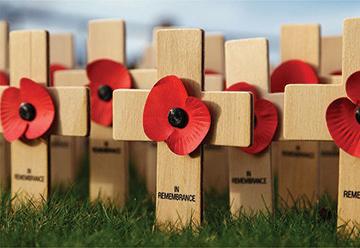
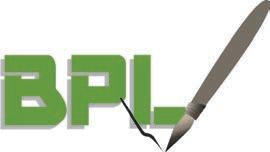
Kindersley, Saskatchewan Died: May 2, 1916 Commemorated at Lijssenthoek Military Cemetery, Belgium
John Affleck Buckham was born March 5, 1889 at The Glebe, Selkirk, Selkirkshire, Scotland. Buckham came with his family to Canada in 1901 and first settled in Westmorland County, New Brunswick. Buckham lived in Kindersley, Saskatchewan before moving to Calgary, Alberta. Living in Calgary with their parents, Buckham and his brother, Thomas, enlisted on March 9, 1915 with the 50th Overseas Battalion. Going overseas to England in October 1915, Buckham went on to serve as a Private with the Canadian Expeditionary Force attached to the 49th Battalion (Edmonton Regiment) during the First World War. Part of the 7th Infantry Brigade, 3rd Canadian Division, the battalion landed in France in October 1915 fighting in the trenches along the Western Front in France and Belgium. On May 2, 1916, Private John Affleck Buckham died of gunshot wounds at No. 10 Casualty Clearing Station and is commemorated at Lijssenthoek Military Cemetery, Belgium. Son of Gideon and Elizabeth (nee Lauder) Buckham of Calgary; brother of Euphemia, Charlotte, Jessie, Bessie, Private Thomas Buckham (49th Battalion) and Isabella; he was 27 years old.
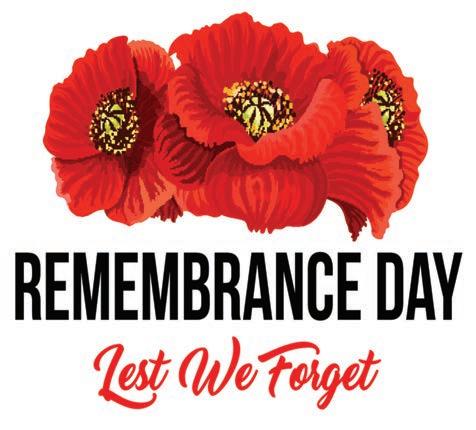

Army Fairmount, Saskatchewan
Died: February 26, 1945 Commemorated at Groesbeek Canadian War Cemetery, Holland
Edward Max Ellefson, born November 8, 1923 at Kindersley, Saskatchewan, attended Prince Edward School in nearby Fairmount where he completed his education in 1940. Single and a farm labourer, Ellefson lived at Fairmount and worked in the district for the Millie Reed Farm at Netherhill, Saskatchewan before enlisting at Regina, Saskatchewan June 7, 1943. Ellefson served with the Royal Canadian Infantry Corps attached to the 1st Battalion, The Black Watch (Royal Highland Regiment) of Canada (Nemo Me Impune Lacessit) as a Private during the Second World War. Part of the 5th Infantry Brigade, 2nd Canadian Infantry Division, the regiment fought at Hoogerheide during the Battle of the Scheldt in October 1944, later moving into the Reichswald Forest in early February 1945 during Operation Veritable. On February 26, 1945, Private Edward Max Ellefson died near Louisendorf, Germany following the breach of the Siegfried Line and capture of German fortifications along the west bank of the Rhine River. He is commemorated at the Groesbeek Canadian War Cemetery, Netherlands and on the Columbaria at Eatonia, Saskatchewan. Only son of Edwin and Christina Louise Ellefson of Fairmount, Saskatchewan; brother of Evelyn Anne Ellefson; he was 21 years old.
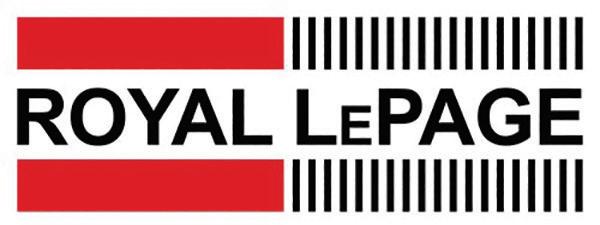
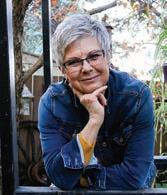
Private Earl Conrad Swalm Army
Gunner Cecil Duffin Bourne Army
Private Edward Max Ellefson
Kenneth J. DrummondRobert England
William Fergusson
Norman Floate
Anne Fuhrman
Ray Fuhrman
Ernie Gard Robert Gardner
Nick Getz
George Goddard John Gordon William Gordon
Sam Grace Ralph Gray
Harold Hawker
George Herman Alan Hubbel Lloyd Hunter
Richard “Jack” Jones Ronald Jones
Thomas Keslick
Eugene Lea
Robert Lee Nelson Lewis
John Lupak William “Bill” MarchantHarold Edwin Martin Vince May Bert McBride Donald McDougall
Zahais (Cy) Ternes
Zahais (Cy) Ternes was born June 1, 1922 near Lemsford, Sask. and in 1926 he along with his family moved to a farm north of Smiley in the RM of Prairiedale. He enlisted in the army on Jan. 16, 1943 serving with the King’s Own Rifles. He spent time training at Port Alberni, Comox, Wainwright & Prince Albert. On March 28, 1945 he disembarked for active duty in continental Europe serving with the South Saskatchewan Regiment in the Netherlands and Belgium. He was discharged from the army Jan. 29, 1946.
In Remembrance of Leslie David Cornish
Leslie enlisted in The RCAF in 1940, in Saskatoon, at the age of 21. He loved to tell the story that the Doctor in charge of their medicals said, when he saw his multicolored hand painted tie and mismatched shirt, “Make sure you check that young man for color blindness!”.
After enlisting, Leslie trained as a mechanic in Toronto and in early 1941 he was sent overseas, as part of the 419 ‘Moose Squadron’, to the RAF Bomber Command Station at Middleton St. George, County Durham. The station’s motto was Shield and Deter. It was later allocated solely to the RCAF.
During the war the squadron members attended many dances in Norton and Darlington, County Durham. It was at a dance that he met Peggy Hall. He told his children often that he knew from the moment he first saw her he would marry her! He courted her steadily, riding eleven miles back and forth from camp on his bike into Norton to see her. They were married in 1945, following the end of the war. He was then sent back to Canada and his bride could only follow a long eight months later, with many other War Brides. They settled for a short time in Demaine, SK. to help on the family farm and then moved to Smiley SK. where Leslie farmed, and later owned and operated Smiley John Deere Farm Supply. He closed the business in the 1960’s and continued farming until the 1970’s. The family moved to Kindersley in 1964 where
they resided until 1995. Peggy and Leslie then moved to Saskatoon to be closer to their children. They resided there until their end of life.
For over 50 years, following the end of the war, the Saskatchewan members of the ‘Moose Squadron’ met for annual reunions, which included all their families. Their bond from their shared experiences of the war was incredible, and lasted life times!
Bill Malindine (Barry Malindine’s) on the right, and his brother Ted at Aunay sur Odon Normandy June 1944.
Bill Malindine took this photo of the North Africa British cemeteries.
Charles McDowell Allan Mills
Melvin Morgan
Raymond Mylrea
William Owens Philip Parton
Gordon Pendree Lorne Purdy
Lewis Quinney Eva & Edward ReedC.M. Richardson (Willis) Bob Salkeld
A.R. Sandbeck Walter H. Seidel Joe Shedlowsky
Donald Staples
Joseph Staples
Michael Steffanick
Robert H. Story
Robert J. Story
William Story Fred Wake
Douglas Webster G.A. Westman
Dave Whatley Robert A. Whatley F.Y. Wildman (Valleau)Collin K. Wyman
Ronald Wannamaker Len Warman
Pinkham, Saskatchewan
Died: February 16, 1945
Commemorated at Groesbeek Canadian War Cemetery, Holland
Floyd Allan Appleby, born January 20, 1918 at Kindersley, Saskatchewan, completed his education in 1935. Working at the oil fields in Turner Valley, Alberta and farming for his parents at Pinkham, Saskatchewan, Appleby enlisted at Saskatoon, Saskatchewan February 12, 1942. Appleby served with the Royal Canadian Infantry Corps attached to the 1st Battalion, The Regina Rifle Regiment (Celer Et Audax) as a Rifleman during the Second World War. On February 16, 1945, Rifleman Floyd Allan Appleby died of wounds at the Regimental Aid Post of the 2nd Battalion, The Glasgow Highlanders following the attack at Moyland Wood. Appleby is commemorated at Groesbeek Canadian War Cemetery, Netherlands. Son of Franklin Taylor and Minetta Adelaide Appleby of Pinkham, Saskatchewan; brother of Harold Franklin, Ralph William and Mrs. John Swift; husband of Alice Wilhelmina (nee Doupe) Appleby of Pinkham; he was 27 years old. Citation(s): 1939-1945 Star, France and Germany Star, Defence Medal, War Medal, Canadian Volunteer Service Medal with Clasp.
We will remember them.
Kindersley, Saskatchewan
Died: September 2, 1918
Commemorated at St. Catharines (Victoria Lawn) Cemetery; Ontario, Canada
Frederick Harman Benson was born July 3, 1886 at Edenvale, Simcoe County, Ontario and moved west to work as a carpenter. Single and working as a carpenter, he moved to Kindersley, Saskatchewan where his sister, Ada, and his mother lived before enlisting there June 12, 1916. Overseas with the 210th Battalion in April 1917, Benson served as a Lance Corporal with the Canadian Expeditionary Force attached to the 49th Battalion (Edmonton Regiment) during the First World War. Landing in France with the 7th Infantry Brigade, 3rd Canadian Division, the 49th fought along the Western Front in France and Belgium. During the Battle of Amiens in August 1918, the 49th broke through a German trench line before capturing the village of Parvillers. On September 2, 1918, Lance Corporal Frederick Harman Benson died while fighting near Drury, France and is commemorated on the Vimy Memorial, Pas de Calais, France. Son of John and Emma (nee Robinson) Benson; brother of Ada Louise, John Walkey and Catherine Mary Benson; he was 32 years old. Citation(s): Victory Medal, British War Medal.
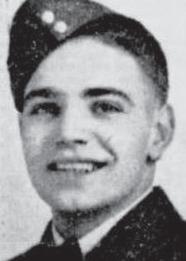
Royal Canadian Air Force
Kindersley, Saskatchewan Died: February 16, 1945
Commemorated at Reichswald Forest War Cemetery, Germany
DonaldJames Campbell, born July 9, 1922 at Brock, Saskatchewan, completed his education at nearby Kindersley High School in 1939. Working for Macdonald’s Consolidating at Kindersley, Campbell enlisted at Regina, Saskatchewan February 2, 1942. Campbell served with the Royal Canadian Air Force attached to No. 198 (R.A.F.) Squadron (Igni Renatus) as a Pilot Officer (Pilot) during the Second World War. Part of 123 Airfield (123 Wing) under the Second Tactical Air Force, the Typhoon squadron operated from RAF Thorney Island, West Sussex, England in attacks on V-1 launch sites and enemy coastal radar installations. On February 16, 1945, Pilot Officer (Pilot) Donald James Campbell died during sweep operations over the Reichswald Forest. Crashing on Johann Jansen’s farm, Campbell is commemorated at Reichswald Forest War Cemetery, Germany. Son of James Campbell (veteran of the First World War) and Clara (nee Cyr) Campbell of Kindersley; brother of Olivina Jean Campbell; he was 20 years old. Campbell Rapids on the Paull River in Saskatchewan is named in his honour. Citation(s): 1939-45 Star, France & Germany Star, Defence Medal, General Service Medal, Canadian Volunteer Service Medal with Clasp.
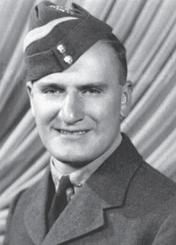
Royal Canadian Air Force
Coleville, Saskatchewan
Died: October 4, 1943 Commemorated at Hotton War Cemetery, Belgium
Raymond Ranger, born October 20, 1921 at Kindersley, Saskatchewan, completed his education in Kindersley in 1937. Working on his father’s farm near Coleville, Saskatchewan, Ranger enlisted at Saskatoon, Saskatchewan July 7, 1941. Ranger served with the Royal Canadian Air Force attached to No. 427 (Lion) Squadron (Ferte Manus Certas) as a Flight Sergeant (Wireless Operator) during the Second World War. Part of No. 6 (R.C.A.F.) Group, Bomber Command, the No. 427 flew Wellington and Halifax bombers from RAF Leeming, Yorkshire, England. On October 4, 1943, Flight Sergeant (Wireless Operator) Raymond Ranger died during air operations to Frankfurt, Germany when his Halifax bomber failed to return to RAF Leeming. Ranger is commemorated at Hotton War Cemetery, Belgium. Son of Ralph and Hortense (nee Bourgon) Ranger of Coleville, Saskatchewan; brother of Robert, Alfred, Gaston and Real; he was 21 years old. Ranger Lake, along the Northwest Territories and Saskatchewan border is named in his honour. Citation(s): 1939-1945 Star, Air Crew Europe Star, War Medal, Canadian Volunteer Service Medal with Clasp.
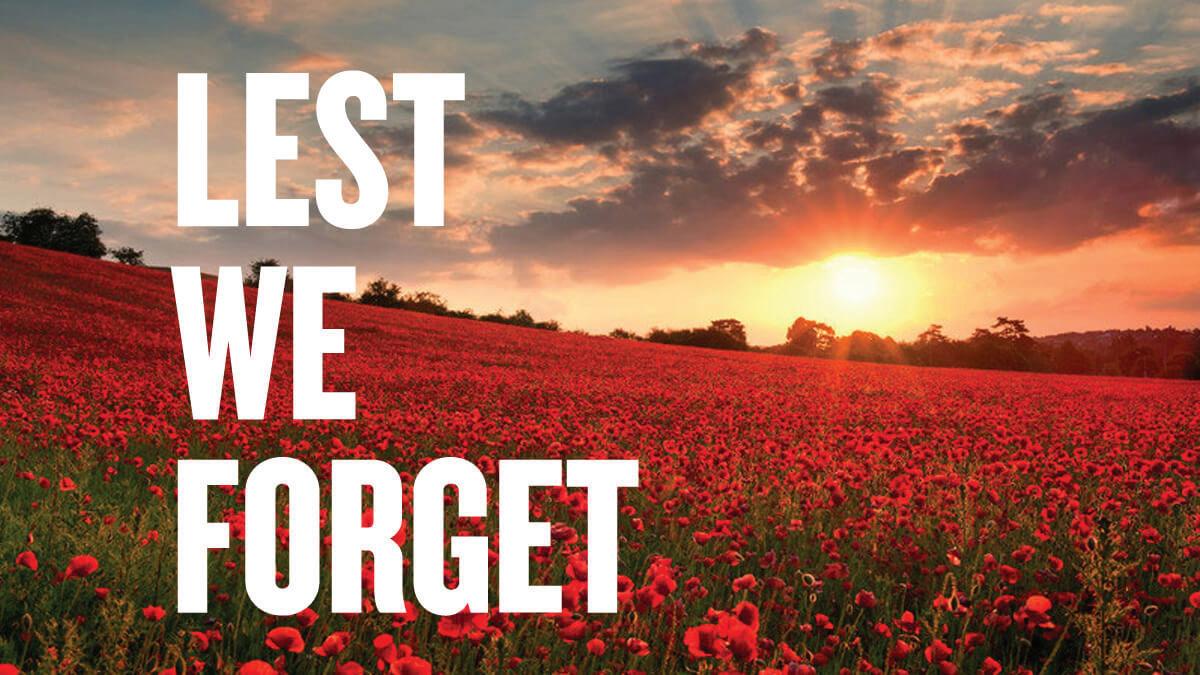
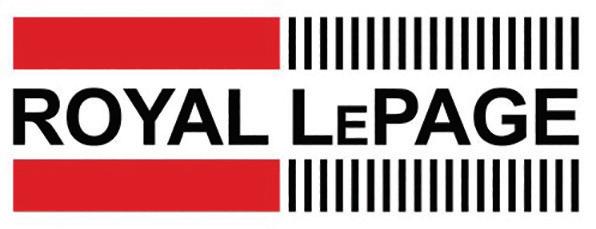
Rifleman Floyd Allan Appleby Army
Private Frederick Harman Benson Army
Pilot Officer Donald James Campbell
Flight Sergeant Raymond Ranger
Sergeant Murray Stewart Dewar
Royal Canadian Air Force
Dodsland, Saskatchewan
Died: January 11, 1943
Commemorated at Hoosier Cemetery
Murray Stewart Dewar, born July 2, 1920 at Dodsland, Saskatchewan, grew up on the family farm in Hoosier, Saskatchewan. After completing his education at Hoosier High School in 1939, Dewar worked on the family farm for a year before working at the Kerr-Addison Gold Mines in Virginiatown, Ontario as a miller. Following enlistment at Saskatoon, Saskatchewan October 4, 1941, Dewar served with the Royal Canadian Air Force (Per Ardua Ad Astra) attached to No. 10 Service Flying Training School at Dauphin, Manitoba as a Sergeant during the Second World War. Under the British Commonwealth Air Training Plan, Dewar attended No. 2 Initial Training School before advancing to No. 15 Elementary Flying Training School, both in Regina, Saskatchewan, learning navigation and training on Tiger Moth and Fairchild Cornell aircraft. Dewar transferred to the No. 10 Service Flying Training School at Dauphin, Manitoba where he flew Harvard and Cessna-Crane aircraft. On January 11, 1943, Sergeant Murray Stewart Dewar died during an instrument training test when his Cessna-Crane crashed north of Ashville, Manitoba. A student pilot and in only his fifteenth month with the Royal Canadian Air Force, Dewar is commemorated at Hoosier Cemetery, Saskatchewan. Son of James S. and Ruby Doris (nee Taylor) of Hoosier; brother of Charles Donald, Gordon Taylor, Mildred Doris, Julene Mary, Claire Elaine and Lois Audrey; he was 22 years old. Citation(s): War Medal, Canadian Volunteer Service Medal.
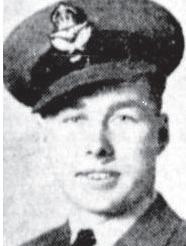
Royal Canadian Air Force
Dodsland, Saskatchewan Died: December 16, 1943 Commemorated at Harrogate (Stonefall), Yorkshire, England
James MacKay, born April 13, 1920 at Tain, Ross-shire, Scotland, came to Canada with his family in June 1925, settling in Saskatchewan as homestead farmers. MacKay completed his education at Viewfair School at Dodsland, Saskatchewan in 1936 before working as a farm labourer on the family farm at Dodsland. Following enlistment at Saskatoon, Saskatchewan December 28, 1942, MacKay served with the Royal Canadian Air Force attached to the No. 426 (Thunderbird) Squadron (On Wings of Fire) as a Flying Officer (Air Bomber) during the Second World War. Part of Bomber Command’s No. 6 (R.C.A.F.) Group and based at RAF Lintonon-Ouse, Yorkshire, England, the squadron flew Lancaster bombers in bombing raids over France and Germany. On December 16, 1943, Flying Officer (Air Bomber) James MacKay died after his Lancaster bomber crashed in bad weather at Yearsley, North Yorkshire following a raid on Berlin, Germany. He is commemorated at Harrogate (Stonefall), Yorkshire, England, on the Bomber Command Memorial Wall, Nanton, Alberta and on the Dodsland Memorial, Saskatchewan. Only son of James Donald and Catherine (nee Campbell) MacKay of Dodsland; brother of Elizabeth and Kate MacKay; he was 23 years old. MacKay Lake, near Thompson Lake, Saskatchewan is named in his honour. Citation(s): 19391945 Star, Aircrew Europe Star, General Service Medal, Canadian Volunteer Service Medal with Clasp.
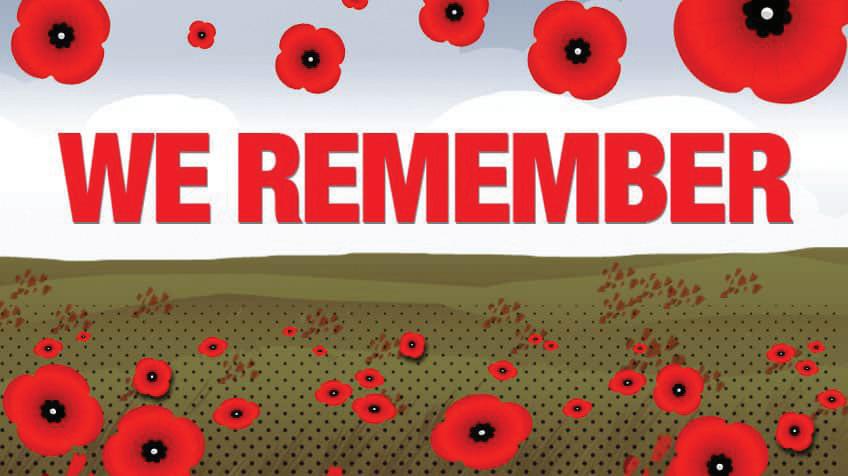

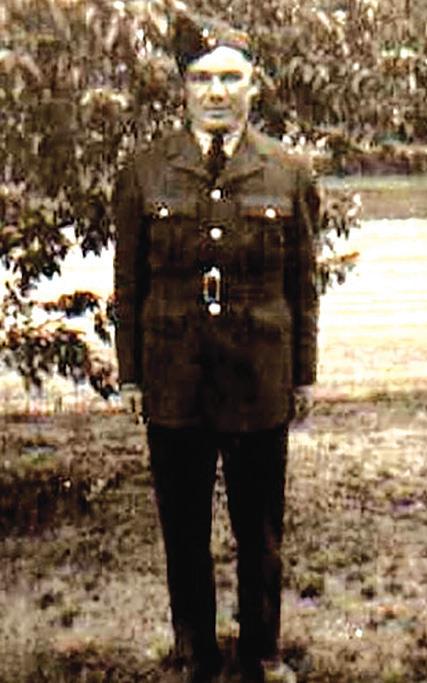
Flight Sergeant John Palmer
Royal Canadian Air Force
Dodsland, Saskatchewan
Died: September 1, 1943
Commemorated at Poix-de-Picardie Churchyard, France
William John Poulin of Dodsland, Saskatchewan served with the Royal Canadian Air Force during the Second World War as a Flight Sergeant Navigator attached to #158 (R.A.F.) Squadron. The squadron took part in many major raids on naval and industrial targets, including the first 1,000 bomber raid, as well as minelaying operations. Poulin was killed in action September 1, 1943 when his Halifax aircraft crashed in France, due to enemy action, while engaged in night operations to Berlin, Germany. The son of Skinner Poulin, a businessman from Dodsland, William John Poulin was 21 years of age and is commemorated at the Churchyard at Poix-de-la Somme, Somme, France.
Saskatchewan Died: July 5, 1943
at Cassino Memorial, Italy
Frank Theodore Peter Netzel served as a Private with the Royal Canadian Army Medical Corps, 9th Field Ambulance during the Second World War. He was killed in action when his Red Cross ship was torpedoed and sunk in the Mediterranean Sea enroute to the invasion of Sicily, July 5, 1943. Private Netzel has no known grave, he is commemorated on the Cassino Memorial, Italy. Of the 49,261 members of the Commonwealth forces who died in the fighting in Italy, nearly one-tenth have no known grave. The 4,054 names recorded on the Cassino Memorial include those of 194 Canadians. Frank was the son of Theodore J. and Stella Netzel husband of Mabel Cecilia Netzel and father of Kenneth of Lucky Lake, Saskatchewan; he was 29 years old. Prior to enlisting in the army Frank worked as a Section Hand with the CNR in Blue River, British Columbia and Mount Netzel northwest of Blue River was named in his honour.
Flight Sergeant William John Poulin
Royal Canadian Air Force
Dodsland, Saskatchewan
Died: September 1,1943
Commemorated at Poix-de-Picardie Churchyard, France
William John Poulin of Dodsland, Saskatchewan served with the Royal Canadian Air Force during the Second World War as a Flight Sergeant Navigator attached to #158 (R.A.F.) Squadron. The squadron took part in many major raids on naval and industrial targets, including the first 1,000 bomber raid, as well as minelaying operations. Poulin was killed in action September 1, 1943 when his Halifax aircraft crashed in France, due to enemy action, while engaged in night operations to Berlin, Germany. The son of Skinner Poulin, a businessman from Dodsland, William John Poulin was 21 years of age and is commemorated at the Churchyard at Poix-de-la Somme, Somme, France.
Mike, Arlene, Jessi & the boys
Sergeant James MacKay
Private Frank Theodore Peter Netzel Army Dodsland,
Commemorated
Saskatchewan
Died: Jul 17, 1944
Commemorated at Bretteville-sur-Laize Canadian War Cemetery, France
Oscar Albrecht, born January 24, 1919 at Leader, Saskatchewan, completed his education in 1936 at Leader. While working for Pioneer Grains there, Albrecht joined The King’s Own Rifles of Canada (M.G.) in 1940. He went on to work for Gas City Flour Mill in Medicine Hat, Alberta before returning to work at Pioneer Grains as a grain buyer. Following enlistment at Regina, Saskatchewan February 17, 1942, Albrecht served with the Royal Canadian Corps of Signals attached to the 2nd Canadian Divisional Signals as a Signalman during the Second World War. Landing in France June 25, 1944 with the 2nd Canadian Infantry Division, 9th Infantry Brigade, the Signals advanced towards Carpiquet, stringing signal lines and providing radio communications for the Allies during the capture of Caen. On July 17, 1944, Signalman Oscar Albrecht died during an assault near Caen and is commemorated at Bretteville-sur-Laize Canadian War Cemetery, Calvados, France. Son of the late William Albrecht and Christine Lehr (Albrecht); brother of Amelia, Fredica, Jacob, John, Lena, Christina, Bertha, Lydia, Rose, Matilda and Pauline; he was 25 years old. Citation(s): 1939-1945 Star, France-Germany Star, Defence Medal, War Medal, Canadian Volunteer Service Medal with Clasp.
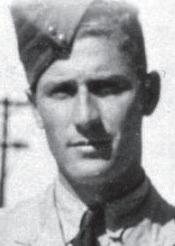
Army Leader, Saskatchewan Died: Apr 5, 1945
Commemorated at Holten Canadian War Cemetery, Holland
Otto Helmer, born November 30, 1918 at Leader, Saskatchewan, completed his education at Mendham, Saskatchewan in 1933. Single, he lived at Leader where he worked on the family farm before moving to Claresholm, Alberta in 1937 to work as a tinsmith helper. While living in Claresholm, Helmer enlisted at Victoria, British Columbia May 21, 1942. Overseas in July 1944 with the Royal Canadian Signals, Helmer went on to serve with the Royal Canadian Infantry Corps attached to the North Shore (New Brunswick) Regiment (Pro Jure Constans) as a Private during the Second World War. Landing on Juno Beach in France June 6, 1944 with the 8th Infantry Brigade, 3rd Canadian Division, the North Shore (New Brunswick) Regiment went on to take part in Operation Windsor and the attack on Carpiquet airfield. Moving into Holland during the Battle of the Scheldt, the regiment advanced into Germany, returning to liberate Zutphen, Holland in April 1945. On April 5, 1945, Private Otto Helmer died of a fractured skull when his motorcycle collided with a military vehicle while delivering a dispatch under blackout conditions near Almen, Holland. Killed instantly, he is commemorated at Holten Canadian War Cemetery, Holten, Netherlands.
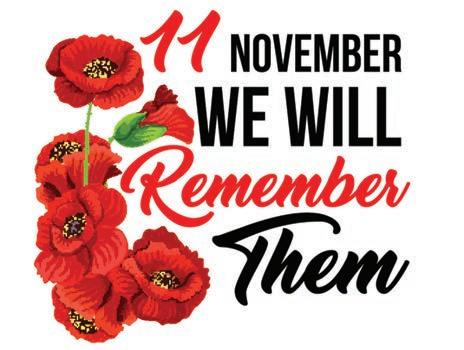
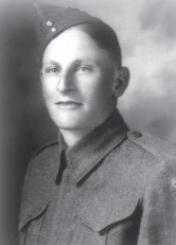
Prelate, Saskatchewan Died: Jul 20, 1944
Commemorated at Bretteville-sur-Laize Canadian War Cemetery, France
NormanPeter Knobel, born June 9, 1916 on the family farm at Prelate, Saskatchewan, completed his education at Prelate in 1932. Working on the family farm with his father, he married in December 1941. Following enlistment at Regina, Saskatchewan, Knobel served with the Royal Canadian Infantry Corps attached to the 1st Battalion, The South Saskatchewan Regiment as a Private during the Second World War. Overseas in July 1943, the battalion landed in France July 8, 1944 where it fought with the 6th Infantry Brigade, 2nd Canadian Infantry Division. On July 20, 1944, Private Norman Peter Knobel died and is commemorated at Bretteville-sur-Laize Canadian War Cemetery, Calvados, France. Son of Bartley Charles and Byrdie Knobel of Prelate; brother of Frederick Charles, Leonard Henry, Evelyn, Charlotte and Dorothy Knobel; husband of Eva Grace Knobel and father of Charles James Knobel; he was 28 years old. Knobel Lake, west of Deception Lake in Saskatchewan is named in his honour. Citation(s): 1939-1945 Star, France-Germany Star, Defence Medal, War Medal, Canadian Volunteer Service Medal with Clasp.
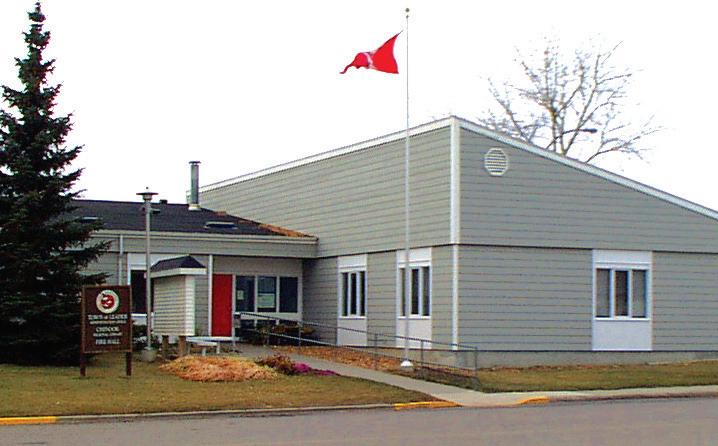
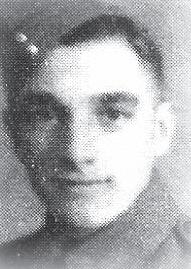
Saskatchewan
Died: July 18, 1944
Commemorated at Bretteville-sur-Laize Canadian war cemetery, France.
JohnGeorge Bichler was the son of Carl and Phyllis (Turnbach) Bichler who came from North Dakota to the Liebenthal district, where John was born, moving to Leader in 1934. John was farming when he enlisted at Regina in 1942.
Walter Celeste Heinzman Army Leader, Saskatchewan
Died: August 19, 1942
Commemorated at Dieppe Canadian war cemetery, Hautot-sur-Mer, Seine-Maritime, France
Signalman Oscar Albrecht Army Leader,
Private Otto Helmer
Private Norman Peter Knobel Army
Private John George Bichler Army Leader,
Lance Corporal
WAR VETERANS Pinkham
WWI (1914-1918)
Addison, Thomas Bruce, Joe Carpenter, Ben Carpenter, Sidney Derraugh, Robert Elder, Frank Fielder, Fred Gardiner, William Gilbertson, George Green, Arthur Green, John William Halliday, Finley Halliday, George
Hummel, Clifford Johnson, Oscar Lenheiser, Herbert McKenzie, Donald Murphy, Charlie Murphy, Walter Nicholls, Joseph Reid, Fred Ritchie, Robert John Rowles, Charles Stapely, Alfred Townsend, Cliff Turner, Alfred Witmer, Harvey Wotherspoon, John
WWII (1939-1945) Adams, Arthur Anderson, Thomas Anderson, William Appleby, Gordon Bruce, Lloyd Bruce, Maitland Cann, Curly Clarkson, Delroy (Roy) Clarkson, Douglas Clayton, Kenneth Clayton, Theodore Derraugh, Douglas Gilbertson, Jack Gregerson, Robert McPherson, G.D. Renwick, Verne Townsend, Robert Veldhoen, Cory
HONOUR ROLL
Appleby, Floyd Ellefson, Edward Lockwood, Duane Lockwood, Merton Renwick, Clifford
Info from “Echoes of Pinkham Pioneers”
Major, Saskatchewan Cemetery. PHOTOS BY KATE WINQUIST
Richard John (Jack) Jones January 10, 1897 - June 26, 1973
1914 World War I - Joined North Hampton Yoemanery Served in Belgium and France April 1915 - April 1917 1917 - Wounded near Aaras and was sent back to hospital. He was on the ship which torpedoed in the English Channel. The ship sank in 20 minutes. He was rescued by the crew from The Destroyer. After convalescence in England, he rejoined the regiment in Italy. Demobilized March 1919.
Past President and Life Member of the Kindersley Branch of the Royal Canadian Legion.
November 16, 1942 - July 24, 1945
Ronald was a Mid Upper Air Gunner and completed 33 operational tours with 626 squadron R.A.F. On December 31, 1944 on a bombing op. over Osterfeld, they were attacked by a ME 109, which they shot down. They crash landed at Manson, England with a wounded R/G and F/E aboard.
Ron was awrded the Distinguished Flying CRoss for his assistance in destroying the attacker.
He was discharged July 24, 1945 and was a member of the Kindersley Branch of the Royal Canadian Legion.
Remembering Air Force photographer, Corporal James Hutchinson
My great grandpa, James Hutchinson was born February 9, 1918 and lived in Richlea, Sask where he worked with his dad at the livery stable. He also worked for farmers and delivered oil in barrels to farmers with his dad until March 31, 1941 when he volunteered for the Royal Canadian Air Force as a photographer and eventually became corporal. My grandpa gave me a bunch of these pictures.
While overseas, one of his jobs as a photographer was to set up cameras in the planes bomb bay, which is where the bomb dropped out of the plane from. He also put cameras in fighter planes air scoops and every time the plane would shoot, the camera would take a picture to count the hits they got. Once while he was putting a camera in a plane in France, a German plane flew over and was shooting at them. He could see bullets bouncing off the runway around him. Sometimes he would go for rides in planes and take his own pictures from the sky. During the war, he took a lot of pictures of enemy planes, some of them were crashed and some look like they were captured, lots of them had been shot down or ran out of fuel and had to be ditched. Someone he met and took a picture of who
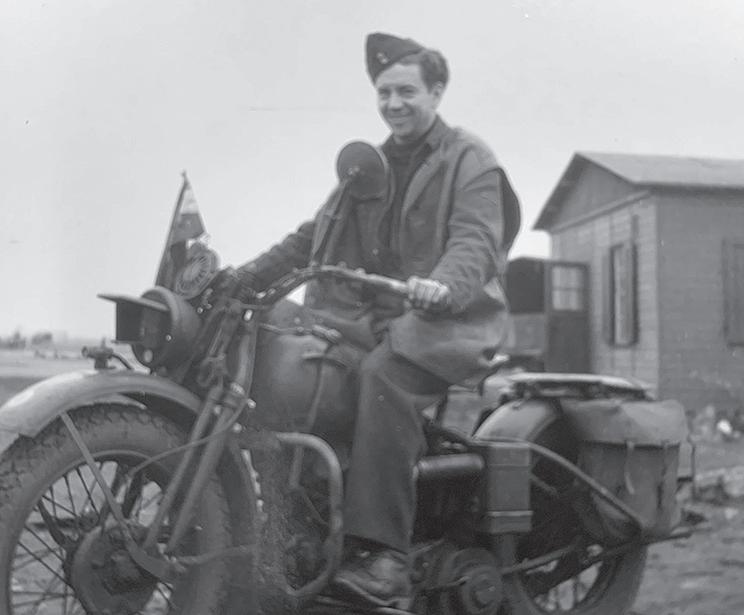
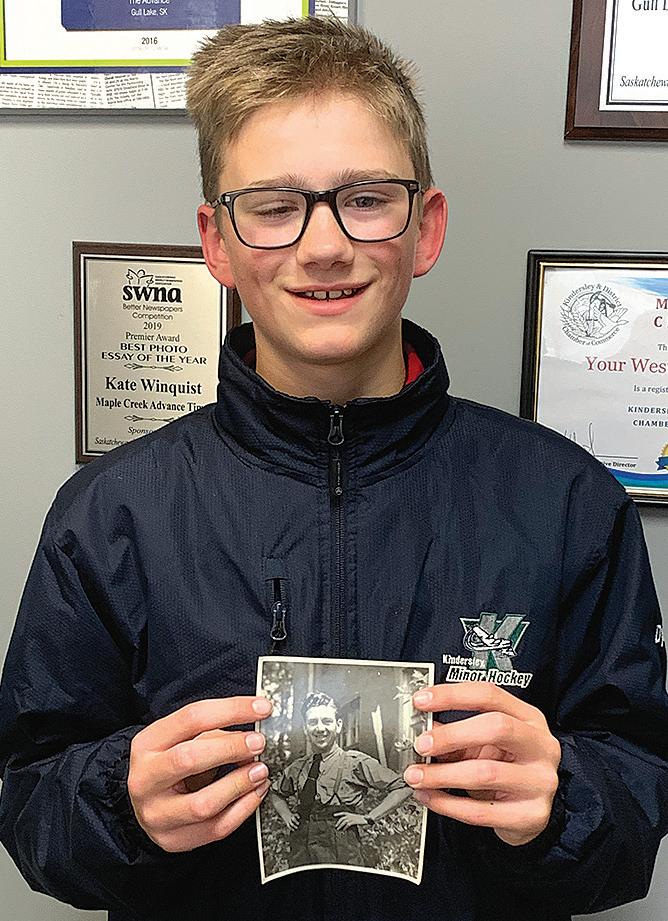
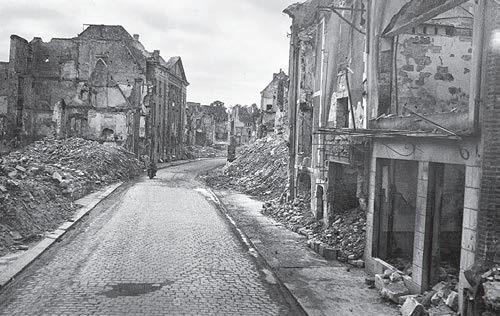
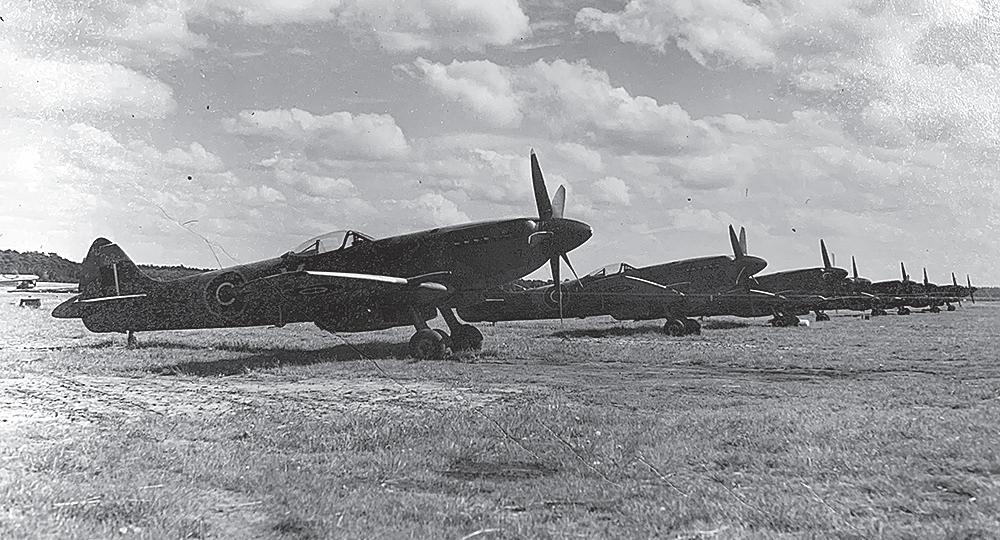
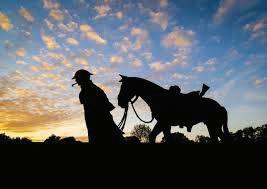
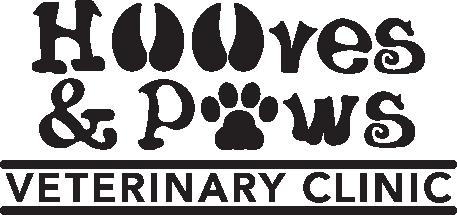
was very important in the war was Winston Churchill. Winston Churchill was the prime minister of England during World War 2. He helped the allies organize D-Day, which is one of the most important events that helped Canada and the allies win World War 2.
During the war, he met his future wife June in England and they got married on April 28, 1945. After they got married, he sent her on a boat to Canada, to live with his family until he got home.
Among his photos are a lot of pictures of towns after they had been bombed, they looked like an old junkyard. There were people cleaning up rubble and piling bricks, there were pictures of concentration camps, planes, trucks and him and his friends hanging out and playing cards. One of the reasons he took so many pictures is because there were contests for the best photos.
My great grandpa James Hutchinson did a lot of interesting things during his time in the air force and was honorably released on October 6, 1945 and he returned to Richlea and became a carpenter. He passed away August 1, 1999 in Victoria, B.C.
I am thankful for all the men and women who served Canada during all the wars.
Keaton Schmidt proudly hoilds a photo of his great grandpa, James Hutchinson.
Private Howard Roy Prescott Army
Kerrobert, Saskatchewan
Died: November 1, 1944
Commemorated at Bergen op Zoom Canadian war cemetery, Noord-Brabant, Netherlands
Howard Roy Prescott (b.1921) was KIA 19441101, the day before his 23rd birthday, at Oude Molen and is buried at Bergen op Zoom Canadian war cemetery, Noord-Brabant, Netherlands. His parents Fred Joseph and Ellen Christina (Oberg) Prescott came from Deerwood, Crow Wing Co., Minnesota, in 1917. Howard was born at Kerrobert and farmed with his family before being called up for NRMA training at Regina early in 1943.
Private Denys Richard Duckett Army
Kerrobert, Saskatchewan
Died: July 20, 1941
Commemorated at Agira Canadian War Cemetery, Italy
L9905
Private (Royal Canadian Ordnance Corps) Denys Richard Duckett (b.1922) of Kerrobert died 19430725 of wounds incurred three days earlier and is buried at Agira Canadian war cemetery, Enna, Sicily, Italy. He was the son of Richard and Margaret Joyce Duckett. Denys was born at Garmston, Shropshire, England, and came to the Kerrobert area with his family at the age of four. He was farming when he enlisted at Saskatoon late in 1941. His family returned to Shropshire after the war.
Gunner Nelson Steele Allcock Army
Kerrobert, Saskatchewan
Died: July 20, 1941
Commemorated at Dodsland, SK
L255
Gunner (2nd Light Anti-Aircraft Regiment, Royal Canadian Artillery) (Nelson) Steele Allcock (b.1918) of Kerrobert died 19410720 and is buried at Brookwood military cemetery near Woking, Surrey, England. Allcock was a despatch rider and died at Lewisham hospital two days after his motorcycle collided with a bus. Steele was born at Pasqua (east of Moose Jaw) to Thomas Everet and Ethel Beatrice Allcock, attended Avoca school, and had just started farming on his own when he enlisted at Regina in 1940. Thomas homesteaded SE16-17-24-W2 northwest of Belle Plaine before resettling just west of the Ermine siding southeast of Kerrobert.
Rudolph (Rudy) Schmidt
Royal Canadian Air Force
Rudy signed up in the army on November 19, 1941. He was only 20 years old. He was enlisted with the British Columbia Dragoons, an army tank regiment.
He served in Italy, France, Germany, the United Kingdom and North Africa. He was assigned to a tank regiment on the front lines.
From a letter sent home at Christmas time, 1943, Rudy was in North Africa. He makes mention that the people don’t wear shoes there, and also that he was so thrilled to be able to pick oranges from the trees in an orchard not far from where he was stationed. He says the first morning he awoke early at 5:00 a.m. and snuck down the road to the orchard and filled his kit bag. He also mentions in this letter to his parents, that there was lots of dates, figs and lemons.
He goes on to say, that he really didn’t care for the country, but that it was a great experience.
Upon his discharge March 8, 1946, when he returned to civilian life, he married Margaret Bosch, and with the help of the VLA (Veteran’s Land Act) they purchased land south of Smiley, Saskatchewan. Together Rudy and Margaret raised six children on their farm.
Flying Officer
Robert Donald Keith Hanbidge
Royal Canadian Air Force
Kerrobert, Saskatchewan
Died: January 8, 1945
Commemorated on the Runnymede Memorial near London, England.
Keith Hanbidge (b.1921) of Kerrobert was KIA on January 8, 1945. Hanbidge’s Lancaster failed to return from a night raid on Munich. Keith was a student when he enlisted at Saskatoon in 1941.
He was the only son of Robert Leith and Jane (Mitchell) Hanbidge. R.L. (Dinnie) Hanbidge QC (1891-1974) was lieutenant governor of Saskatchewan 196370. He was born in Bruce Co., Ontario, to parents who hailed from Wicklow, Ireland. He came west in 1909, articled with F.W.G. Haultain and settled at Kerrobert in 1914. Hanbidge was a Conservative MLA 1929-34 and a federal candidate in 1945. Dinnie acquired his unusual nickname while playing with the Regina Rugby Club, forerunner to the Roughriders.
Kerrobert, Saskatchewan
Died: April 22, 1945
Rifleman (Regina Rifles) Herbert Hubert Hugo Hilbach (b.1915) of Kerrobert was KIA 19450422 at Groningen during the liberation of the Netherlands and is buried at Holten Canadian war cemetery, Overijssel, Netherlands. Herbert was the son of William and Wilhelmina (Salzwedel) Hilbach, a German couple who came to Saskatchewan via the United States and homesteaded SE36-35-23-W3 north of Kerrobert. Herbert was farming when he enlisted at Regina early in 1942. His younger brother Rudolph also served overseas in the Army.
Rifleman Herbert Hubert Hugo Hilbach Army
Elrose Honour Roll
Elrose Cenotaph

















































































































































































































